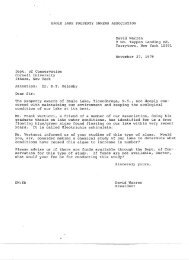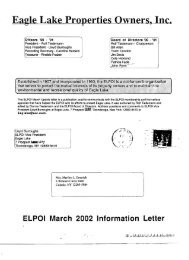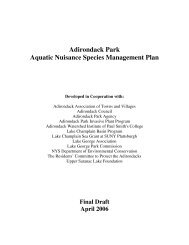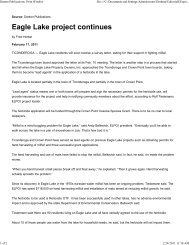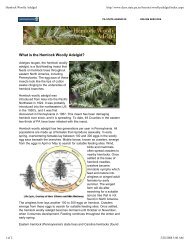THE NEED FOR MILFOIL CONTROLMuch has been \vritten on the need for management of invading non-native species (Miller,1994; Cunningham and Saigo, 1999), and specifically on the need for control of Eurasian\vatern1ilfoil (Newroth, 1979; Shireman et aI., 1982; Hoyer and Canfield, 1997). Still morediscussion has been held at a wide variety of symposia and workshops devoted to environmentalmanagement in general or aquatic plant management specifically (e.g., those of the NorthAmerican <strong>Lake</strong> Management Society and Aquatic Plant Management Society). There are bothecological and economic reasons for controlling milfoiI. Ecologically, this plant displaces nativespecies and decreases biodiversity. It also provides limited habitat value when dominant,negatively affecting aquatic fauna. Economically, milfoil creates nuisance conditions whichimpair recreational use and reduce property value. Milfoil impacts should be considered on threescales: localized impacts, lakewide impacts, and regional impacts.Localized ImpactsAt the scale of the individual plant, milfoil is just one more species in a large assemblage in mostlakes where it has just been introduced. If the native community persists and maintainsdominance, scattered individual milfoil plants are not a major threat. They do not appear to addany appreciable structure to the community beyond that which most native plant speciesassemblages already possess, but an individual milfoil plant is only a problem for chancerecreational encounters, due to entanglement. The problem is that rarely does the nativecommunity withstand milfoil invasion indefinitely, or even for more than a few years. Eurasianmilfoil has become the dominant plant in the vast majority of lakes in which it has beenintroduced in less than 10 years (Carpenter, 1980; Wagner, pers. obs.). If not attackedaggressively in the early stages of establishment, the likelihood of expanded milfoil coverage isvery high, with concurrent loss of native assemblages and associated habitat value.The ecology of the species involves reproduction primarily by vegetative means, usually byfragmentation of plant tips or by root crown expansion. Root crown expansion appears to be thedominant means of local expansion, while fragments are the primary means of more distantdissemination and colonization (Madsen and Smith 1997). Both are highly effective means ofpropagation. Adventitious roots form on the plant tips, allowing rapid re-rooting and growth ofnew plants. Viable fragments may be produced by motorboat propellers, but fragmentation isnaturally most prevalent in the autumn when assemblages of annual species dependent upon seedgermination have died back, providing ample open substrate for the milfoil to colonize.Fragments persist through the northern winter, can grow with low light availability, and initiaterapid growth (as much as 1 ft per week) in the spring before many seeds have germinated.Likewise, established plants with expanded root crowns can send up new stems earlier in thespring than most other species in northern lakes. Rapid dominance is thereby ensured in mostcases.At the scale of the bed, milfoil is predominantly a recreational problem by virtue of its-location.Occurrence of beds in shallow water in swimming or docking areas creates an impediment tohuman access and use which is usually evident by the start of more intensive spring use (postMemorial Day). \Vhile other species can create nuisance conditions, the early appearance andD<strong>SEIS</strong> for <strong>Eagle</strong> <strong>Lake</strong> 8 ENSR
severity of the milfoil nuisance are matched in northern waters only by fanwort (Cabombacaroliniana), another aggressive non-native species, and sometimes by curly-leaf pondweed(Potamogeton crispus), a species which declines by early July in most cases.Dense beds have limited habitat value, but as part of a mosaic plant assemblage with differentmorphologies, a single milfoil bed is not a major detriment to aquatic ecology. Again, however,such a situation rarely persists. As Eurasian watermilfoil is a species with a "disturbanceecology" (i.e., it is well adapted to be opportunistic in response to disturbances which makehabitat available), it normally becomes the dominant plant and can nearly exclude other species.This creates a transition to the lakewide scale of the problem represented by this species.The pace at which milfoil became established in <strong>Eagle</strong> <strong>Lake</strong> appears slightly slow for thisspecies, but a continuous record of expansion in the lake is lacking. Seventeen years afterapparent first detection, it is one of the three most abundant species in the lake along withcharophytes (advanced algae such as Nitella) and Robbins pondweed (Potamogeton robbinsii).Some additional expansion of milfoil is possible, but it is already the dominant species in water 2to 4 m deep, the preferred depth range of this species.Arguments are sometimes made in favor of letting milfoil invasions run their course, much likean epidemic of some sub-lethal virus. It has been postulated that invasive species are eventuallybrought under control by natural forces and become just one more species in the assemblage, butwe have only scant information and a very short history with regard to most species. If eventualintegration into the aquatic plant community occurs, existing evidence indicates that it will not bebefore great loss of biological diversity, habitat value, recreational utility, and economic benefit.Additionally, the timeframe for assimilation of a new, invasive species is unknown, butpostulated to be on the order of a century or more. For Eurasian watermilfoil specifically, it isstill a problem plant in lakes that have had this species in them since the 1950s. Unless we arewilling to experience substantial and prolonged losses in the many facets of lake value, action isnecessary.Early and preventive action is much preferable to later large-scale restoration. Efficient milfoilcontrol requires acting at the level of localized impacts, not waiting until there is a lakewideproblem. Unfortunately, milfoil become dominant in <strong>Eagle</strong> <strong>Lake</strong> before any substantial actioncould be taken. Now it is necessary to deal with the problem on a lakewide basis to gain controlof this nuisance exotic species.<strong>Lake</strong>wide ImpactsOn the lakewide level, dominance by milfoil is routinely equated with a loss of habitat value andmajor recreational impairment. The displacement of native plant species, particularly those withlow-growing morphologies or high light requirements, has resulted in population reductions orelimination of certain species of benthic invertebrates, alteration of cover for fish, and areduction in food quality for herbivorous waterfowl (Shireman et aI., 1982; Keast, 1984; Baker etaI., 1993). With specific regard to fish, the density of milfoil beds leads to excess survival ofyoung of the year fish and subsequent intense competition for food resources, such that stuntedD<strong>SEIS</strong> for <strong>Eagle</strong> <strong>Lake</strong> 9 ENSR
- Page 1 and 2: - -'- --:;:;;;-- -.-----.. ----- -
- Page 3 and 4: TABLE OF CONTENTSEXECUTIVE SUMMARY
- Page 5 and 6: EXECUTIVE SUMMARYEurasian watennilf
- Page 7 and 8: PROJECT SETTING AND BACKGROUND INFO
- Page 9 and 10: -....... E-~E-
- Page 11: The nuisance aquatic macrophyte .My
- Page 15 and 16: Regional ImpactsWhen multiple lakes
- Page 17 and 18: Table 1. Eagle Lake Submersed Vascu
- Page 19 and 20: Sonar® is considered to have low t
- Page 21 and 22: leading to the recommendation that
- Page 23 and 24: However, if the treatment can be ap
- Page 25 and 26: Physical ControlsTABLE 3. MANAGEMEN
- Page 27 and 28: TABLE 3. MANAGEMENT OPTIONS FOR CON
- Page 29 and 30: TABLE 3. MANAGEMENT OPTIONS FOR CON
- Page 31 and 32: TABLE 3. MANAGEMENT OPTIONS FOR CON
- Page 33 and 34: TABLE 3. MANAGEMENT OPTIONS FOR CON
- Page 35 and 36: Benthic BarriersThe use of benthic
- Page 37 and 38: Benthic barriers have been used at
- Page 39 and 40: expected when light penetrates to t
- Page 41 and 42: undoubtedly applicable; this is a d
- Page 43 and 44: Key issues in choosing a harvester
- Page 45 and 46: Drawdo\vn has a long and largely su
- Page 47 and 48: Chemical ControlsThere are few aspe
- Page 49 and 50: and Getsinger, 1993) have revealed
- Page 51 and 52: A1ilfoil WeevilThe use of insects t
- Page 53 and 54: dissemination and growth with seedi
- Page 55 and 56: luegill (Leopomis macrochirus), and
- Page 57 and 58: eradicated from the system. The oth
- Page 59 and 60: depression is expected. Field tests
- Page 61 and 62: MONITORING PLANFluridone Monitoring
- Page 63 and 64:
REFERENCESArnold, W.R. 1979. Flurid
- Page 65 and 66:
Getsinger, K.D., GJ. Davis and M.M.
- Page 67 and 68:
NaIl, L. and J. Schardt. 1980. Larg
- Page 69 and 70:
Tanner, C., R. Wells and C. Mitchel
- Page 71 and 72:
aterAT LAKE GEORGEBASELINE AQUATIC
- Page 73 and 74:
SummaryEurasian watennilfoil (Myrio
- Page 75 and 76:
Adirondack Mountains in the Hudson
- Page 77 and 78:
Aquatic Plant PopulationsAquatic pl
- Page 79 and 80:
Grid EnumerationThe pennanent grids
- Page 81 and 82:
Diver Swimover SurveyDiver swimover
- Page 83 and 84:
Daubenmire, R. 1959. A canopy-cover
- Page 85 and 86:
APPENDIX I. Aquatic Plant Survey Da
- Page 87 and 88:
EAGLE LAKE SONAR DEMONSTRATION PROJ
- Page 89 and 90:
EAGLE L~KE SONAR DEMONSTRATION PROJ



